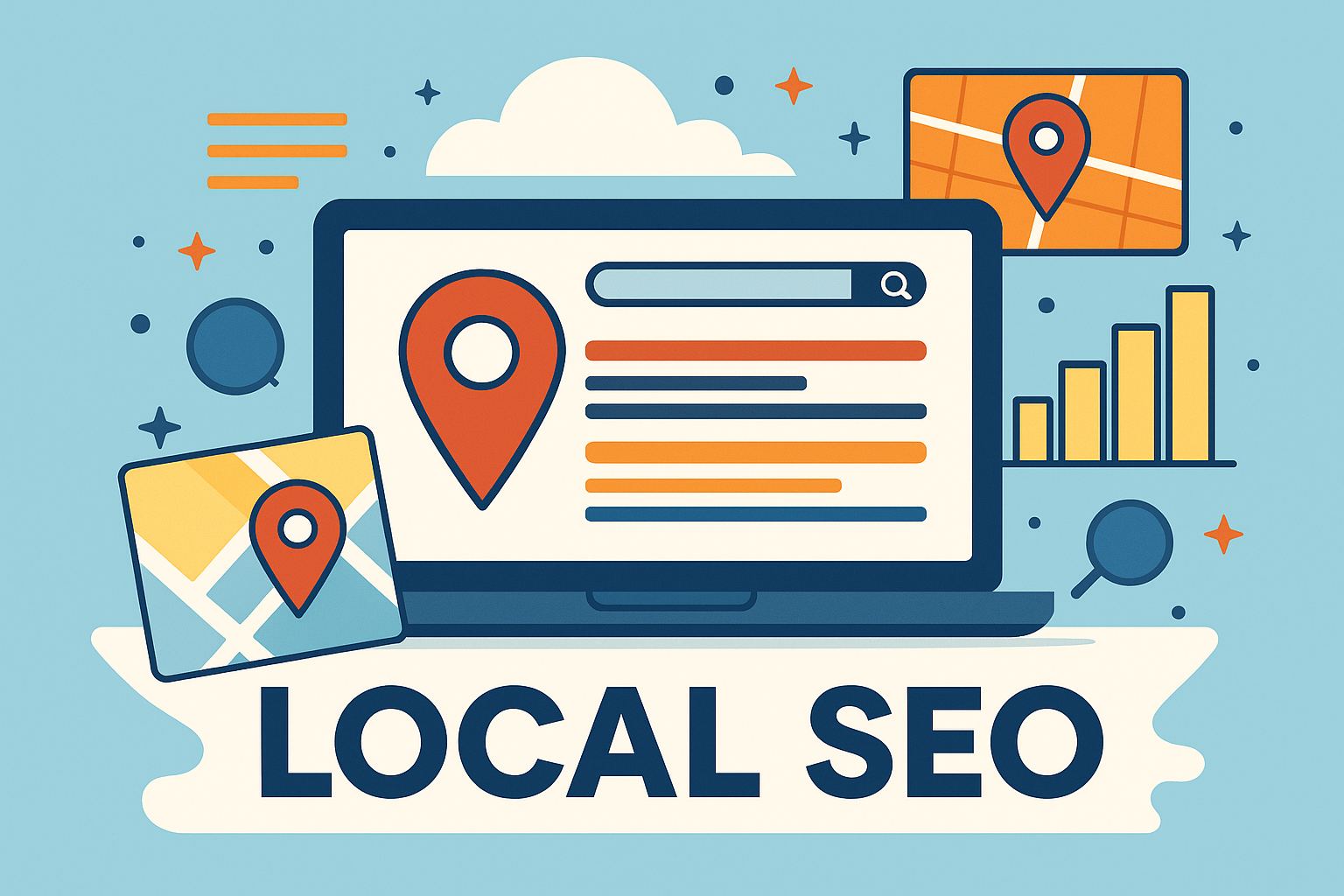Many small business owners dread SEO (Search Engine Optimization) thanks to the confusing jargon, endless updates, and too many “quick fix” promises in this space.
On top of that, we’ve met many businesses who were pitched great results by an SEO marketing company, only to have nothing to show for it a year or two in.
Local SEO today doesn’t have to be all that complicated: the things that are good for your users and prospective customers are largely the things that are good for helping you “show up” when your prospects look for you.
We try to keep it simple and practical, with one clear focus: helping your business be findable, credible, and trusted.
Here are some basics on how to tackle local SEO well, plus the framework we use to evaluate and improve our clients’ web presence.
Quick Local SEO Tips You Can Start Today
- Claim and update your Google Business Profile and keep your business hours accurate and up to date. Post occasional “updates” that show your work. That could be as simple as a pristine, completed home for a house painter.
- Ask happy customers to leave online reviews.
- Check that your website loads quickly on mobile devices and is optimized for both the Google map pack and organic search results.
- Add pages to your website to describe your core services: for example, a page for kitchen remodeling and another for bathroom remodeling. Both help search engines understand where you should show up online. Additionally, a single-page website will almost never do as well as a growing, multi-page website.
- Publish one to two blogs a month answering relevant local search questions from your target audience. This demonstrates to search engines and users that you’re a subject matter expert!
- Consider location specific landing pages so nearby customers know where you work.
- Keep your business listings consistent with the correct name, address, and phone number across business directories like Apple, Bing, and other smaller websites.
- Engage with your local audience by being active on social media and posting good pictures of your work or team-members: people like to buy from people, and social media is an important source of proof for your work.
- Bonus: consider winning more mentions in your local press by sponsoring local events or joining regional Chambers of Commerce. These can point more links to your website, which can be a signal to search engines that you’re “real” plus that you’re “involved!”
Why Local SEO Still Matters
SEO isn’t just for tech companies; it’s how a local business gets discovered. When people search online for services or products using search engines like Google, SEO is what makes one company stand out over another.
Local intent searches like “plumber near me” or “best carpenter Lancaster” dominate search engines every day. Without consistent local SEO efforts, your competitors are the ones showing up in those local search results instead of you. Strong local rankings – the “rank” or “position” that you show up on the list of websites you’ve seen in search results – can mean the difference between attracting customers or losing them to other local businesses that invest in their business’s online presence.
Let’s get some definitions out of the way:
Search Engines: Platforms such as Google, Bing, and other search engines that index, rank, and display websites when people type in questions or local keywords.
Search Engine Optimization (SEO): The practice of improving a website so it appears higher in search engine results, bringing more visitors who are actively looking for your services.
Generative Search Optimization (GSO): A newer approach that prepares your content to be cited or used directly in AI-generated answers from tools like ChatGPT, Perplexity, or Google’s AI mode.
Queries or keywords: The exact words or phrases people type into Google Search or Google Maps to find local businesses, services, or information.
Rank or Position: The placement of a website in search engine results for a given keyword or query. For example, showing up in the first position on Google can drive much more traffic than appearing in position 25.
Intent: The underlying purpose behind a user’s search query. For example, someone typing “pizza near me” has the intent to find and possibly order from a nearby restaurant. In local SEO, matching your content to searcher intent helps improve local rankings and local search visibility.
Indexing: The process search engines use to store and organize the content they discover on websites so it can be shown in future search results.
Our Local SEO + GSO Framework
Our local SEO strategy and thought framework is built on 3 pillars that support the “findability” of a website and a business’ online presence. Your business’ online footprint – consisting of your website as well as your social media and Google Business Profile – all work in concert to elevate your work.
The best local SEO strategy considers everywhere that your business shows up.
Here, we explain how each “pillar” contributes to your success in search.
Pillar 1: On-Website Technicals
A website has to load quickly, have intuitive navigation for both people and robots, and be mobile-friendly. Navigation and page structure should be straightforward so customers can find what they want without friction.
Search engines work by sending out virtual robots that crawl and index websites nonstop, and a technically clean site helps them understand and trust your pages just as much as humans
The goal here is simple: eliminate obstacles for both search engines and humans by optimizing your websites “guts.” A well-built website from an experienced web design company usually takes this into consideration from the start. If you’ve hired the building of your website to a professional, this is usually taken care of for you.
Using tools like Google Search Console and platforms like SEMRush and Ahrefs lets us identify technical issues and monitor local SEO performance.
Pillar 2: On-Website Content
This is where most of the ongoing local SEO work and effort happens.
Your website needs to be technically quick, but it also needs to explain what you do! Create core “service pages” that explain what you do and who you serve. For a carpenter, that might mean a dedicated page for kitchen remodeling, and another page dedicated to bathroom remodeling. These help search engines understand that you should show up for people searching for bathroom remodeling services AND kitchen remodeling services.
Next, you’ll need helpful content. Long-form blogs and articles that answer real customer questions help in building authority in the eyes of search engines; in other words, you are the “expert” in your industry.
Consider building location-specific landing pages. These pages are cover your services in one area and signal to Google Maps and other search engines where you operate and who your local audience is.
We perform local keyword research to find valuable local keywords that reflect relevant local searches. Writing content that includes target keywords, business information like your address and phone number, and answers to search queries increases the likelihood of appearing in both the Google map pack and organic search results.
And, at least of this writing, a growing website is a successful website: the more helpful pages on your website, the better. We generally recommend that business owners expand their website with 1-3 new pages per month, which include articles, local landing pages, or new service pages. A growing website also signals to search engines that you care about your online presence!
Pillar 3: Off-Site Signals
Off-website activity strengthens your business’s online presence holistically: this includes social media, Youtube, review websites, and your Google Business Profile.
Google Business Profile optimization helps you appear in both the local pack and organic search results. You want updated business hours; periodic posting to the profile, ideally including real images of your work or crew; and most important of all, lots of reviews from customers! Online reviews build trust with potential customers and influence ranking factors.
Make sure you have a Facebook page for your business, Instagram, Youtube channel, and even Tik Tok if you have the time. In a perfect world, post to each once a month or so, using images of your work or people at your business. And if you have the aptitude, create videos for Youtube showing your team in action or even just describing the kinds of work you do. Social media is just one way search engines validate your online presence.
Backlinks from other websites, local citations in business directories, and consistent business listings with the correct name address and phone help boost credibility in the eyes of search engines, too. You want Apple Maps and Bing Maps both showing the same information about your business as Google Maps, and it can even be helpful to have websites like YellowPages.com (we know, no one is going there these days) and other smaller sites updated with the correct business information. We use third-party tools like BrightLocal to speed up this business listing effort.
What’s New: Generative Search Optimization (GSO)
“But wait” you say: isn’t AI changing all of this?
Yes, generative AI tools like ChatGPT, Perplexity, and Google’s new search modes are reshaping how people find answers. Instead of showing a list of links, they synthesize information from authoritative sources. This makes local SEO important in a new way: if your content isn’t structured, clear, and comprehensive, it may not be pulled into AI-generated results.
Local SEO optimization and GSO are now two sides of the same coin.
Keys to success with GSO include topical authority through FAQs and explainer blogs, structured answers that cover search queries thoroughly, and strong off-site proof like online reviews and Google Business Profile activity.
See a pattern? These are all things we’ve been advocating as part of good SEO to begin with. Helpful content, good reviews, and optimized business information still form the backbone of GSO visibility. While this will inevitably change with time, much of the same good hygiene for your online presence will persist into the AI era.
Case Study #1: Concrete Coating Company
Curious for some real-world examples?
In December 2023, we began working with a concrete coatings company that wanted more visibility and more customers. We optimized their website, wrote longform articles targeting valuable local keywords, and added location specific landing pages.
Their local SEO performance took off: organic traffic climbed from nearly zero to well over 1,000 monthly visits. Keywords now rank high in local search results, and more customers are finding their services online.

Case Study #2: Tree Service Company
Over the course of about two years, we partnered with a tree service company that wanted to gain more traction in their local area.
We focused on building location specific landing pages, writing long-form educational articles, and optimizing their Google Business Profile with consistent updates and online reviews.
The results speak for themselves: as the chart below shows, their organic traffic rose dramatically from almost nothing to well over 1,000 monthly visits. This growth illustrates how steady local SEO work (combined with strong business listings, local citations, and accurate business information) can transform visibility in search engines for service-based companies.

Why Our Clients Are Already Ahead of the Curve
For years, we’ve built websites filled with long-form, question-answering content. That is exactly what search engines and AI tools favor today. By avoiding shortcuts like spammy backlinks and focusing on genuine local SEO work, our clients enjoy stronger local rankings, more satisfied customers, and better local search visibility. Their business’s online presence is prepared not just for Google search results but for how generative AI presents information, too!
Combined with sponsoring local events, using high quality images, and keeping business information up to date, this well-rounded local SEO strategy helps attract more customers from the local area and nearby customers actively searching for services.
Wondering About Outsourcing The SEO To a Team That’s Done It Before?
Local SEO optimization doesn’t have to feel like hand-waving magician’s tricks.
At Little Mountain Printing, we take care of the details so you can focus on attracting customers and running your business. With the right local SEO strategy and thoughtful local SEO work, you can reach more customers, improve local search visibility, and build trust with search engines.
Want to stop dreading SEO and start getting found by your local audience? Let’s connect!







